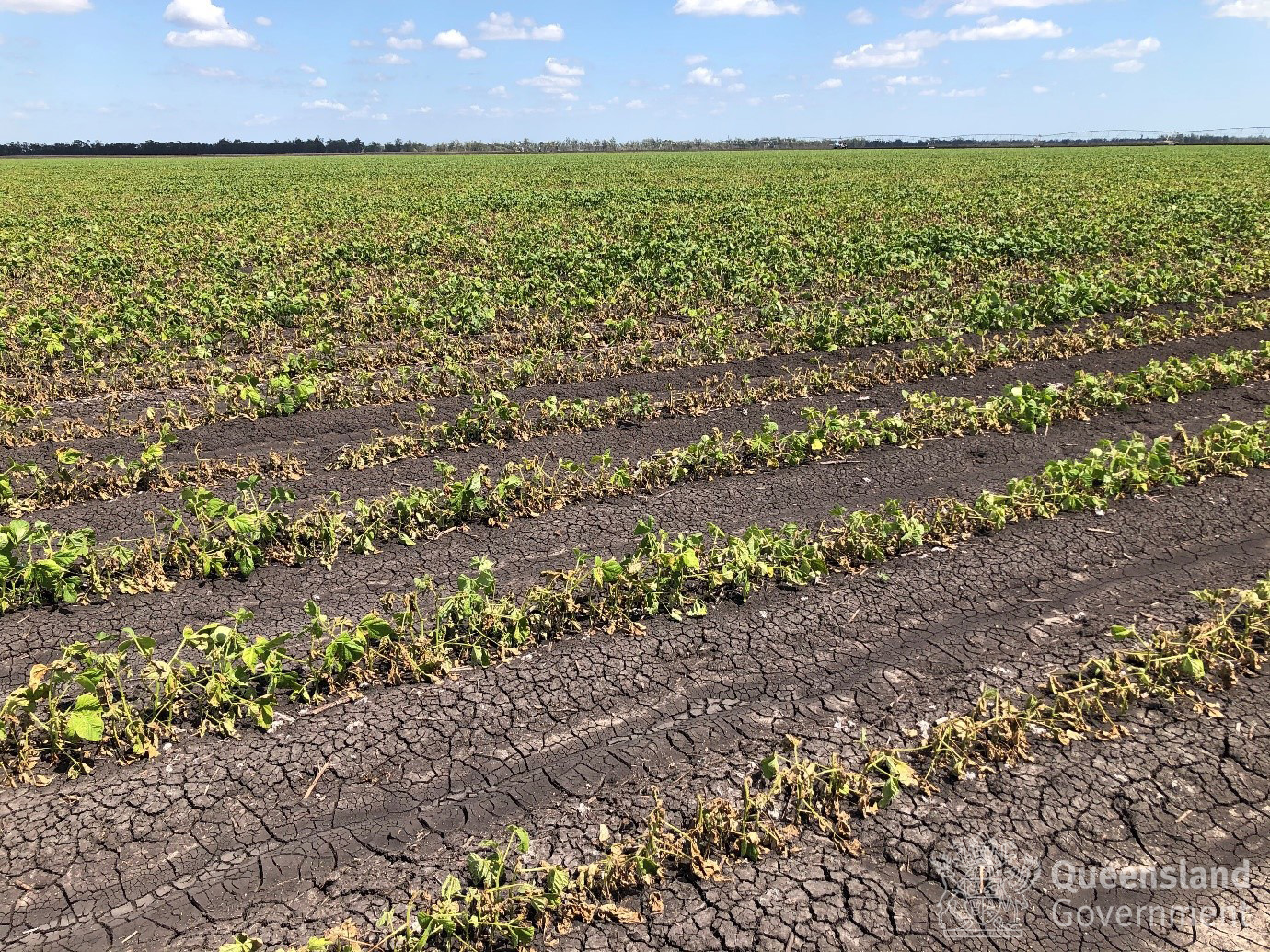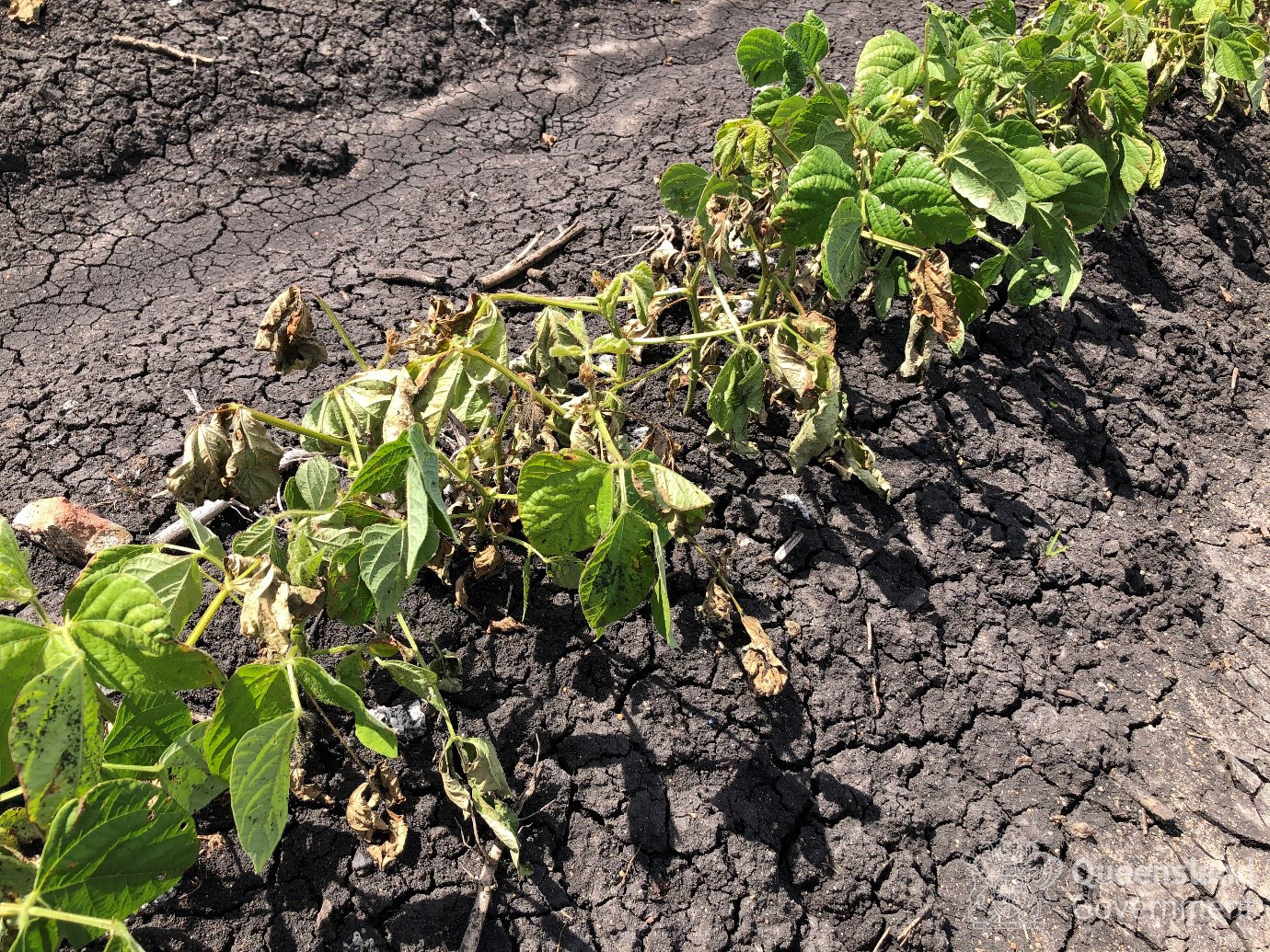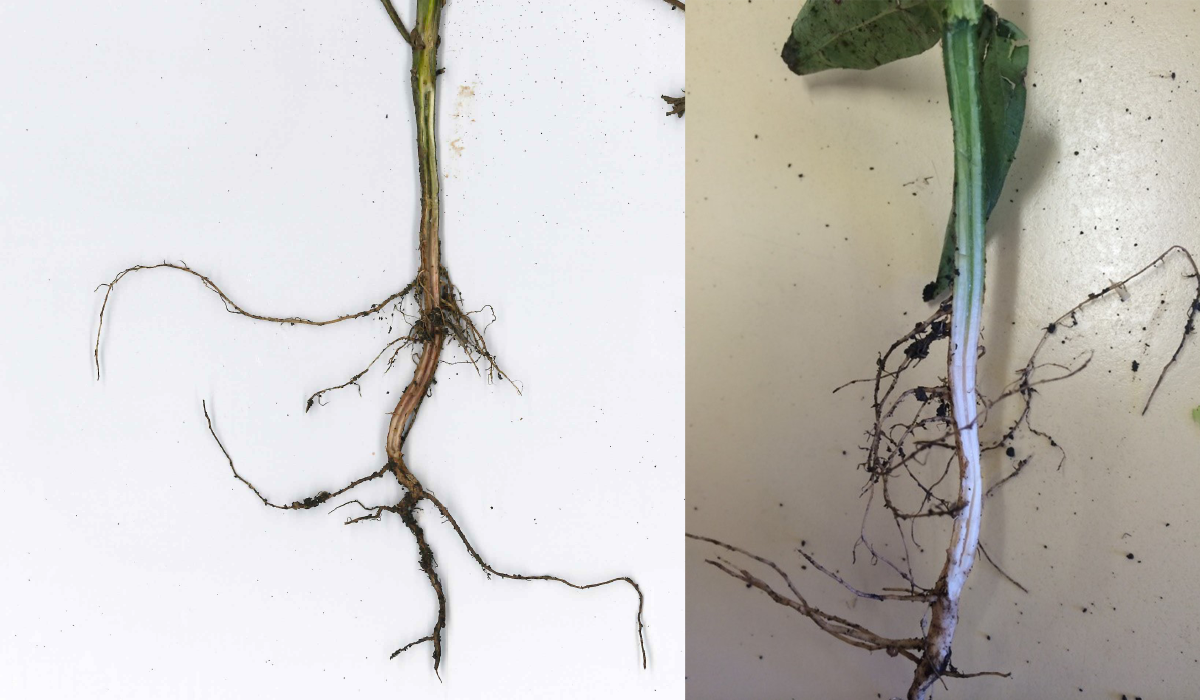Several growers and agronomists across southern Queensland have reported extensive damage to their mungbean crops due to Fusarium wilt this season. Large areas of affected paddocks have plants that are wilted or dead, resulting in significant yield losses.
The results of DAF annual disease surveys over the last five years have found that the disease is most common in crops grown in southern Queensland on heavier clay soils.
The wet start to the 2020 cropping season has seen many crops experiencing waterlogging stress, making plants more susceptible to Fusarium wilt.

Wilting and plant death caused by Fusarium wilt in a Jade-AU* crop of mungbeans in March 2020 on the Darling Downs (Photo: L. Kelly)

Vascular tissues of infected plants are blocked by the Fusarium pathogens, resulting in wilt and plant death (Photo: L. Kelly)
Plants may be infected at any stage of growth, however symptoms are more frequently seen on maturing plants after flowering. It is likely the increased stress of flowering makes plants at this stage more susceptible to the effects of the disease.
Surviving plants that were infected early will remain stunted. Leaves of affected plants turn yellow and then wilt. The taproot of affected plants often rots, resulting in poor growth. When the stem and root of an affected plant is split open longitudinally a brown discolouration of the vascular tissues can be seen. This discolouration is a diagnostic symptom of Fusarium wilt.

Extensive discolouration of vascular tissues in an affected plant (left) vs healthy vascular tissues in healthy plant (right). (Photo: L. Kelly)
What is Fusarium wilt and how does it spread?
Fusarium wilt in mungbean is caused by fungi within the F. oxysporum and F. solani species complexes. Both species produce resistant spore structures (chlamydospores) that can survive in soils for many years (exactly how long is not yet known). Fusarium can spread to unaffected paddocks on soil and crop debris attached to machinery, and through the movement of irrigation and flood water.
Successive plantings of mungbean will increase the population of Fusarium in the soil, making disease more likely in subsequent mungbean crops unless a suitable crop rotation is used. Glasshouse trials have demonstrated that these Fusarium species can survive in the roots of other crops without producing disease symptoms. This work needs to be repeated under field conditions to confirm these results and to determine the best rotation practices. The pathogens survived in the roots of barley, chickpea, soybean, cotton, and to a lesser extent, sorghum plants during glasshouse studies. This means that the pathogens will survive between mungbean plantings on the roots of asymptomatic crops. Similar results are found in other Fusarium pathogens. These glasshouse studies found that the pathogens did not survive as well in the roots of sorghum plants and therefore sorghum is likely to be a better crop rotation choice.
How is it managed?
Factors that reduce root growth will increase susceptibility to the pathogens that cause Fusarium wilt. Drought or excess moisture stress increases the risk of infection.
To minimise the risk of Fusarium wilt developing, growers should;
- Avoid planting mungbean in previously affected paddocks for at least five years. With each successive mungbean planting, the growth in pathogen population will increase the risk of causing severe disease. Long bare fallow and then sow to a crop that will reduce pathogen survival, such as sorghum.
- When a bare fallow is not an option, stubble from the following crop should be burnt, baled or incorporated into the soil as soon as possible after harvest to minimise the build-up of the pathogen in the soil.
- Manage stubble and crop debris left over from an affected mungbean crop as soon as possible after harvest
- Plant into well-drained soils that have been optimally fertilised to encourage rapid seedling growth and reduce the risk of root rot
- Minimise soil compaction and hard pans
- Manage plant populations, row spacing, and soil moisture to limit moisture stress
- Remove volunteer mungbeans and control weeds
- Manage irrigation water to prevent spreading the pathogen to unaffected paddocks
- Practice good farm hygiene. Remove soil and crop debris from vehicles, machinery, and boots before moving between paddocks. Come clean – go clean.
There are currently no registered chemicals for the control of Fusarium wilt in mungbean.
Research by DAF and USQ is underway to determine whether there is an interaction between root lesion nematodes and the pathogens that cause Fusarium wilt.
Breeding varieties that are resistant to the Fusarium wilt pathogens will be important for the future management of the disease. All current commercial mungbean cultivars are susceptible to the disease, although Celera II-AU* and the black gram (Vigna mungo) cultivars, Regur and Onyx-AU* offer slight resistance.
Where to send disease samples?
Growers and advisers are advised to inspect crops closely for disease. If disease is suspected, then call or email [email protected] or phone 0477 747 040 who will advise on the best approach to collect and process samples.
This research is supported through the Grains Research and Development Corporation (GRDC) through the projects Surveys and associated diagnostics of the incidence and severity of diseases of cereal and pulses within the Northern Region (DAQ1907-001RTX) and Integrated disease management tools to manage summer crop diseases in the Northern Region (USQ1907-001RTX).
*These mungbean varieties are registered under PBR.
